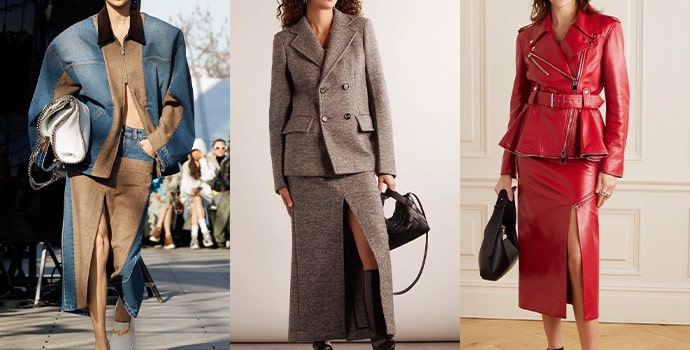Understanding Clothes: The Importance of Fabric Selections in Your Closet
The selection of fabric in clothing plays a critical duty in both aesthetic appeals and performance. Different products use differing degrees of comfort, breathability, and longevity, straight influencing the wearer's experience. Recognizing these nuances can boost one's wardrobe markedly. Several ignore just how these choices can impact not simply individual design, but likewise sustainability. What fabric decisions could redefine your closet and align it with both style and responsibility?
The Role of Textile in Style and Functionality

Typical Material Kinds and Their Qualities
When picking clothing, comprehending the qualities of typical material types is essential for making informed selections. Cotton, a widely-used all-natural fiber, is known for its soft qualities, breathability, and flexibility, making it appropriate for laid-back wear and everyday garments. Linen, another all-natural option, boasts excellent moisture-wicking residential properties and an unique structure, ideal for warm climates.Wool, commonly preferred for its warmth and longevity, varies in fineness; merino wool is soft versus the skin, while coarser types are utilized for outerwear. Synthetic fabrics like polyester and nylon provide resilience and resistance to wrinkles, making them prominent for activewear and traveling garments. Blends, which combine synthetic and all-natural fibers, can boost capability while preserving convenience. By identifying these textile qualities, people can choose clothing that straightens with their way of life and aesthetic preferences.
Breathability and Convenience: Picking the Right Fabrics for Different Climates
Selecting the ideal fabrics for various environments can considerably enhance comfort and overall wearability. Breathable products are vital in hot environments, as they permit air flow and moisture evaporation. Fabrics such as cotton, linen, and moisture-wicking synthetics successfully draw sweat far from the body, keeping the user cool and dry. Conversely, in cooler climates, thicker fabrics like woollen or fleece provide insulation while retaining breathability, guaranteeing warmth without overheating.Additionally, the choice of fabric weight plays a crucial role; lightweight materials are more effective for summer season, whereas larger alternatives are suited for winter months wear. Understanding the unique properties of each textile allows people to clothe appropriately for varying climate condition. Inevitably, selecting breathable and comfortable materials tailored to details climates can substantially boost daily comfort and boost the overall experience of using garments.
Toughness and Treatment: Just How Textile Influences Longevity of Your Wardrobe
Choosing the ideal materials can greatly impact the toughness and treatment demands of a closet. Fabrics such as cotton and polyester are understood for their resilience and ease of upkeep, making them optimal for everyday wear. On the other hand, delicate materials like silk and shoelace need more cautious handling and specialized cleansing methods, which can enhance the moment and effort needed for care. Branded Clothing.Durability is also influenced by the material's weave and finish; snugly woven textiles tend to withstand deterioration far better than freely woven choices. Furthermore, synthetic blends typically give enhanced sturdiness, integrating the most effective qualities of numerous fibers.Understanding the care instructions for each fabric is vital, as improper drying or washing can cause early wear. Eventually, picking durable products can cause a longer-lasting closet, decreasing the regularity of replacements and adding to a more lasting fashion option
The Impact of Textile on Fit and Silhouette

Lasting Textile Options: Making Eco-Friendly Choices
The effect of material prolongs beyond fit and shape to include environmental variables, triggering an expanding passion in sustainable material choices. Environmentally friendly materials, such as organic cotton, hemp, and Tencel, are getting grip amongst consumers that prioritize sustainability in their wardrobes. These products are typically generated with less chemicals and water, minimizing their environmental footprint.Additionally, recycled materials, made from post-consumer waste, supply a cutting-edge option to the textile sector's contamination problem. Brands progressively accept transparency in their sourcing techniques, enabling consumers to make educated decisions concerning their purchases.Choosing sustainable materials not only sustains ethical practices however also urges the garment industry to adopt more liable manufacturing approaches. As awareness of environmental problems increases, individuals are urged to assess the lasting influence of their material selections, fostering a movement towards a much more lasting and this eco mindful method to style.
Boosting Design: Exactly How Fabric Can Change an Outfit
While many might concentrate on color and cut when picking an outfit, the choice of fabric plays an important function in boosting style and improving overall look. Different products convey unique state of minds and messages; as an example, silk exhibits high-end and elegance, while denim supplies a casual, kicked back ambiance. The texture and drape of a textile can substantially alter the shape, with organized textiles offering a polished appearance and softer ones producing an extra fluid, kicked back aesthetic.Moreover, the weight of the textile influences wearability throughout periods. Light-weight fabrics like linen and cotton are suitable for summer season, while much heavier materials such as wool and velour supply warmth and sophistication in chillier months. Recognizing fabric residential properties, such as breathability and stretch, additionally encourages individuals to make educated choices that improve comfort without compromising style. Eventually, the best material can transform an attire from average to amazing, making it an essential factor to consider in any type of wardrobe.
Regularly Asked Questions
How Do I Identify the Material Material of My Apparel?
To recognize material material, one can take a look at treatment labels, conduct burn tests for fiber identification, or get in touch with material examples. These techniques help set apart materials, guaranteeing educated selections for apparel care and maintenance in daily wear.
Can Material Choice Affect My State Of Mind or Self-confidence?
Material selection can considerably impact an individual's mood and self-confidence. Branded Clothing. Particular products might stimulate sensations of convenience or sophistication, while others can feel restrictive or uncomplimentary, ultimately affecting self-perception and psychological health throughout the day
What Fabrics Are Ideal for Sensitive Skin?
For people with sensitive skin, all-natural fabrics like linen, bamboo, and cotton are usually recommended. These materials are breathable, hypoallergenic, and less likely to create irritability, making them ideal choices for comfort and skin wellness.
Just how Do I Correctly Wash and Care for Different Fabrics?
To effectively care and clean for different textiles, one need to think about each material's certain needs, including temperature settings, detergents, and drying methods, ensuring longevity and preserving the textile's original high qualities for optimal use.
Are There Certain Fabrics for Athletic or Efficiency Wear?
Athletic or performance wear frequently utilizes fabrics such as spandex, nylon, and polyester. These products are designed for moisture-wicking, breathability, and flexibility, enhancing activity and convenience during physical activities while supplying durability and assistance. Alternatively, in cooler climates, thicker materials like wool or fleece offer insulation while retaining breathability, ensuring warmth without overheating.Additionally, the selection of material weight plays a vital duty; light-weight fabrics are better for summer season, whereas much heavier choices are suited for wintertime wear. In contrast, delicate materials like silk and lace call for more careful handling and specialized cleaning methods, which can raise the time and initiative required for care.Durability is also affected by the material's weave and coating; firmly woven fabrics tend to resist wear and tear much better than loosely woven options. In contrast, rigid textiles can restrict activity yet offer a timeless, refined look.Moreover, the thickness and appearance of the fabric can influence the visual assumption of body form. The impact of textile extends beyond fit and shape to include environmental factors, prompting an expanding passion in sustainable Our site textile choices. The appearance and drape of a fabric can drastically alter the silhouette, with structured fabrics providing a refined look and softer ones producing a more fluid, relaxed aesthetic.Moreover, the weight of the material influences wearability across periods.
Comments on “How Branded Clothing Can Boost Confidence Through Fabric and Feel”